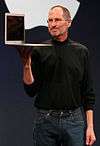Reality distortion field
Reality distortion field (RDF) is a term coined by Bud Tribble at Apple Computer in 1981, to describe company co-founder Steve Jobs's charisma and its effects on the developers working on the Macintosh project.[1] Tribble said that the term came from Star Trek.[1] In the Menagerie episode, it was used to describe how the aliens created their own new world through mental force.
Later the term has also been used to refer to perceptions of Jobs's keynote speeches (or "Stevenotes") by observers and devoted users of Apple computers and products.[2]
Description and uses
The RDF was said by Andy Hertzfeld to be Steve Jobs's ability to convince himself and others to believe almost anything with a mix of charm, charisma, bravado, hyperbole, marketing, appeasement and persistence. RDF was said to distort an audience's sense of proportion and scales of difficulties and made them believe that the task at hand was possible. Jobs could also use the RDF to appropriate other's ideas as his own, sometimes proposing an idea to its originator after dismissing it the week before.[3]
The term is also used by Apple's competitors when they criticize Apple. On Research In Motion's official BlackBerry blog, Jim Balsillie introduced a blog post by saying “For those of us who live outside of Apple’s distortion field”.[4]
Jobs's reality distortion field was parodied in Dilbert: Dilbert built a functioning reality distortion field emitter, which is used during Dogbert's keynote speech,[5] while previous strips parodied iPhone flaws.[6] In chapter three of the 2011 biography of Steve Jobs, titled Steve Jobs, biographer Walter Isaacson states that around 1972, while Jobs was attending Reed College, Robert Friedland "...taught Steve the reality distortion field...”
The term has extended in industry to other managers and leaders who try to convince their employees to become passionately committed to projects without regard to the overall product or to competitive forces in the market. It also has been used with regard to hype for products that are not necessarily connected with any one person.[7] Bill Clinton's charisma has been called a reality distortion field.[8] The chess champion Bobby Fischer was said to have a "Fischer aura" surrounding him that disoriented Boris Spassky and other opponents.[9] The term has associated with Donald Trump's approach to running his 2016 campaign for United States President.[10]
Financial Times used the term when describing Elon Musk.[11]
See also
- Apple fanboy
- Charismatic authority
- Cult of personality
- Locus of control
- Magical thinking
- Propaganda
- Suggestibility
- Suspension of disbelief
References
- 1 2 Hertzfeld, Andy (February 1981). "Reality Distortion Field". Folklore.org.
- ↑ Dudrow, Andrea (October 16, 2000). "Notes from the Epicenter: Exploring the Reality Distortion Field". CreativePro.
- ↑ Hertzfeld, Andy. "Reality Distortion Field". www.folklore.org. The Original Macintosh. Retrieved 13 February 2015.
- ↑ "RIM Responds to Apple's 'Distortion Field'". Inside BlackBerry. October 19, 2010.
- ↑ "Dilbert comic strip for 2010-09-23". The official Dilbert comic strips archive.
- ↑ Adams, Scott. "Reality Distortion Field". The Scott Adams Blog. Retrieved May 10, 2013.
- ↑ "The Ajax Reality Distortion Field". davidtemkin.com. April 12, 2005. Archived from the original on June 18, 2010.
- ↑ Ferriss, Tim (November 21, 2010). "How It Works: Clinton's "Reality Distortion Field" Charisma".
- ↑ Darrach, Brad (1972-08-11). "Bobby is Not a Nasty Kid". Life. p. 40. Retrieved March 25, 2013.
- ↑ O'Brien, Timothy L. (2016-06-16). "A Peek Inside Trump's Smoke and Mirrors Tour". Bloomberg View. Retrieved 2016-07-29.
- ↑ Richard Waters. Elon Musk, billionaire tech idealist and space entrepreneur. Financial Times.
